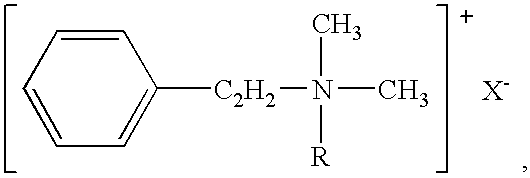NMDA receptor antagonist formulation with reduced neurotoxicity
- Summary
- Abstract
- Description
- Claims
- Application Information
AI Technical Summary
Benefits of technology
Problems solved by technology
Method used
Image
Examples
example 1
Randomized, Placebo-Controlled, Double Blind Study of the Safety and Efficacy of PMI-100 for the Treatment of Breakthrough Pain in Patients with Chronic Malignant Pain
[0036]This example evaluates the safety and efficacy of a ketamine hydrochloride formulation with preservative delivered through a nasal spray. Plasma levels were measured for the bioavailability and for correlating blood levels with analgesic effect.
Methods
[0037]The study is a randomized, multi-center, placebo-controlled, double-blind, crossover trial with 20 patients who had chronic malignant pain and a pattern of 2-7 episodes of daily breakthrough pain, despite taking stable doses of analgesic medication. After an initial screening visit (visit 1), patients completed 2 study visits at least 48 hours apart; one visit for treatment with a PMI-100 formulation (visit 2), and a second visit for treatment with placebo (visit 3). The PMI-100 formulation is an aqueous intranasal ketamine formulation containing 10% (w / v) ket...
example 2
An Acute Subcutaneous Neurotoxicity Study in Rats with PMI-100
[0083]This Example evaluates the neurotoxicity of a formulation of ketamine hydrochloride (referred to hereafter as “PMI-100”) in rats following a single subcutaneous injection. PMI-100 is a formulation containing 100 mg ketamine / ml and 0.002% benzalkonium chloride. The findings are based on the level of neuronal vacuolation.
Materials and Methods
[0084]This study included 160 rats with 16 male and 16 female rats in each of the following five treatment groups: Group 1 was given sterile water for injection (control); Group 2 was given 4 mg / kg PMI-100; Group 3 was given 15 mg / kg PMI-100; Group 4 was given 60 mg / kg PMI-100; and Group 5 was given 0.5 mg / kg MK-801. Four rats of each sex in each of these five groups were allocated to four study subgroups (Subgroups A, B, C, and D). The rats in Subgroup A were necropsied approximately six hours post-dose. Those in Subgroup B were necropsied approximately 24 hours post-dose. The r...
example 3
[0115]A 28-Day Subcutaneous Neurotoxicity Study in Rats in PMI-100
[0116]The objective of this study was to evaluate the potential neurotoxicity of the test article in the rat following multiple subcutaneous injections of the PMI-100 formulation containing 10 mg / kg (10% w / v) ketamine hydrochloride and 0.002% benzalkonium chloride solution. The formulation was given once daily over a 28-day period.
Methods
[0117]192 rats were distributed across five treatment groups as indicated in Table A. Summary information, including dosing information and the stains employed for evaluating the brain sections, are presented in Text Tables A and B, below.
[0118]
TABLE AExperimental Study Design - Acute Neurotoxicity StudyApproximateDoseDoseNo. of AnimalsDoseDose LevelConc.VolumeGroupMaleFemaleMaterial(mg / kg)(mg / mL)(μL / kg)12020Vehicle0060022020PMI-10041004032020PMI-1001510015042020PMI-l006010060051616MK-8010.3-0.53-5100
[0119]
TABLE BSubgroup Information - Acute Neurotoxicity StudySubgroupDesignationStudy...
PUM
| Property | Measurement | Unit |
|---|---|---|
| Fraction | aaaaa | aaaaa |
| Fraction | aaaaa | aaaaa |
| Fraction | aaaaa | aaaaa |
Abstract
Description
Claims
Application Information
 Login to View More
Login to View More - R&D
- Intellectual Property
- Life Sciences
- Materials
- Tech Scout
- Unparalleled Data Quality
- Higher Quality Content
- 60% Fewer Hallucinations
Browse by: Latest US Patents, China's latest patents, Technical Efficacy Thesaurus, Application Domain, Technology Topic, Popular Technical Reports.
© 2025 PatSnap. All rights reserved.Legal|Privacy policy|Modern Slavery Act Transparency Statement|Sitemap|About US| Contact US: help@patsnap.com

